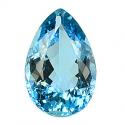March: Aquamarine
March Birthstone: Aquamarine
Birthstone Color: Light to Medium Blue

Aquamarine Myths & Historical Facts
If you can picture the cerulean blue waters of the Mediterranean, you will understand why the birthstone for March is named Aquamarine. Derived from the Roman word "Aqua," meaning water, and "mare," meaning sea, this pale blue gem does indeed resemble the color of seawater. The ancient Romans believed that the Aquamarine was sacred to Neptune, the god of the sea, having fallen from the jewel boxes of sirens and washed onto shore. Early sailors wore aquamarine talismans, engraved with the likeness of Neptune, as protection against dangers at sea.
The association with water led to the belief that the Aquamarine was particularly powerful when immersed. Water in which this gemstone had been submerged was used in ancient times to heal a variety of illnesses of the heart, liver, stomach, mouth and throat. Aquamarines were also used to reverse poisoning and to aid in fortune telling.
The Aquamarine is a member of the beryl family. Beryl is a mineral that crystallizes within large grained igneous rocks on the earth's crust. It varies in color from clear to vibrantly colored gemstones such as the Emerald. It is a very hard mineral, making the Aquamarine a durable gemstone for use in jewelry.
A gift of Aquamarine symbolizes both safety and security, especially within long standing relationships. Some people even say that the Aquamarine reawakens love in a tired marriage, so if you want to bring back that spark in your partner's eyes, you might consider this gem as an anniversary gift!
Aquamarine Facts
Aquamarine: Aquamarine ranges from very light to medium blue, which is often tinted by a splash of green.
Aquamarine evokes the colors of the sea: from deep green-blue hues to light, slightly greenish blue. They are often free from inclusions and clear as water too, symbolizing purity of spirit and soul. Aquamarines make fantastic gemstones for evening wear because they glitter and gleam even under muted light conditions. During the day or in bright light, they exhibit a soothing coolness.
Aquamarine belongs to the beryl species of gems and is closely related to emerald, morganite and golden beryl, among others.
It is a durable gemstone with a hardness of 7.5-8.0 on the Mohs Hardness Scale.
Nature produces a variety known as cat’s-eye aquamarine, a rare, highly collectible, phenomenal variety.

